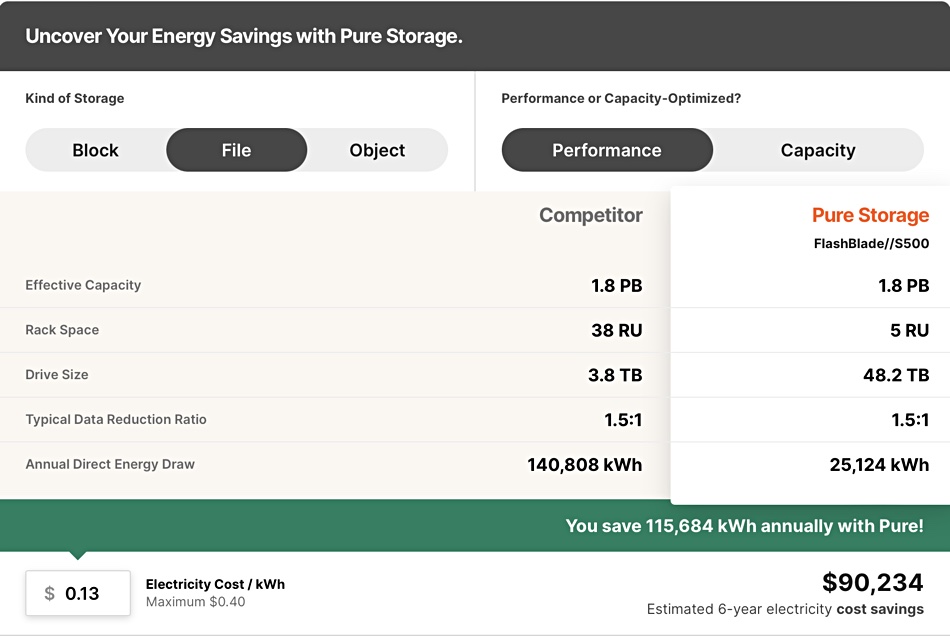Pure Storage has released a sustainability report claiming its products can help datacenters use less electricity, pressing the pressure points of customers that want to hit carbon emissions targets and are worried about regulators homing in on their use of energy and water.
The paper, titled Drivers of Change: Pure Storage IT Sustainability Impact Survey 2022, is accompanied by an Energy Savings Visualizer, which enables businesses to see Pure’s estimated electricity cost savings based on performance or capacity-optimized block, file, or object storage.
Ajay Singh, Pure’s chief product officer, said: “This inaugural report on the central role that IT can play in overall sustainability can be an important tool to help IT leaders improve their data storage strategies and decrease their organization’s carbon footprint as they advance their digital transformation.”

Datacenters account for 1 percent of global electricity consumption today, according to the paper. Pure says that by building and adopting sustainable technology infrastructure, IT teams have the potential to make a significant and immediate impact to use less electricity for power and cooling and also create less e-waste.
The commissioned report, carried out by Wakefield Research, surveyed more than 1,000 sustainability managers in the US, UK, France and Germany. It looked at organizations’ sustainability efforts, with sustainability mainly focused on electricity consumption and the underlying carbon emissions. The highlights include:
- Sustainability initiatives are a priority but half of sustainability managers are behind on sustainability goals
- 86 percent of sustainability program managers think companies can’t achieve sustainability goals without significantly reducing technology infrastructure energy usage.
- Just over half say the sustainability of vendors’ technology is likely to be overlooked during the selection process.
- Around half say the IT team is considering sustainability when making decisions about technology purchases.
78 percent say their company’s leadership is treating sustainability initiatives as a priority, but only about half (51 percent) are on track with their goals. Just under a third of the surveyed companies (32 percent) are focused on becoming carbon neutral.
The report declares that 81 percent said the impact of technology infrastructure on a company’s carbon footprint will increase in the next 12 months. Pure says it is lowering the carbon emissions of its products moving forwards. Last year it said it wanted to achieve a 66 percent reduction per PB in sold product Scope 3 emissions.
It believes there should be industry-wide standards for reporting power efficiency so that customers can make informed and reliable choices as sustainability becomes a bigger factor in technology purchasing decisions.
Analyst view
William Blair analyst Jason Ader said he believed Pure has an “opportunity to displace near-line hard disk (due to the declining cost of NAND and its energy efficiency).” He added: “Pure’s proprietary ‘Direct Flash’ hardware architecture, in which flash management software is applied against a pool of raw NAND flash (as opposed to off-the-shelf SSDs, which virtually every other storage vendor, including the CSPs, leverages), is the company’s key technical differentiator in the storage market and leads to industry-leading density, performance, and data reduction efficiency.”
In other words, at least theoretically, you need less flash capacity in Pure’s all-flash arrays than competing vendors’ AFAs and so less electricity is needed during their operation for power and cooling. The electricity savings against all-disk and hybrid flash/disk arrays are even greater.
Ader notes: ”Pure sees NAND price declines as a catalyst for greater displacement of near-line hard disk drives, which are still the prevalent form factor for capacity-based enterprise storage systems.”
Comment
Pure’s belief that there should be industry-wide standards for reporting power efficiency has a ready-made framework; the SNIA’s Emerald program and its Storage Device Level Power Efficiency Measurement (SDLPEM) activities.
The width of the “Industry-wide” concept needs defining in a storage industry sense. Suppliers whose products depend on moving components, such as hard disk drives (HDD) and tape drives and the systems that use them – disk arrays, tape autoloaders and tape libraries – will use far more electricity than solid-state drives on the one hand and storage software on the other.
But tape drives only require power when in use and tape cartridges spend more time offline than online. Tape is likely inherently greener than disk. Perhaps disk power-down, think Copan, will return from its technology cemetery.
The emissions created during HDD and NAND manufacturing will also need to be considered.
Developing an industry-wide reporting standard will require all suppliers thinking they have been treated equally and not put at a disadvantage because their kit inherently causes more carbon emissions, such as HDDs and tape drives. The SNIA Emerald working group has a quite difficult job on its hands.
Pure hints in its report that sustainability issues should be present earlier in the IT technology procurement process than at present. This might mean that they would become a more important factor and that would potentially place HDD vendors at a considerable disadvantage versus potential replacement technologies, such as the QLC flash gear supplied by Pure Storage and VAST Data. It’s likely that more flash array suppliers will discover the joys of QLC.







